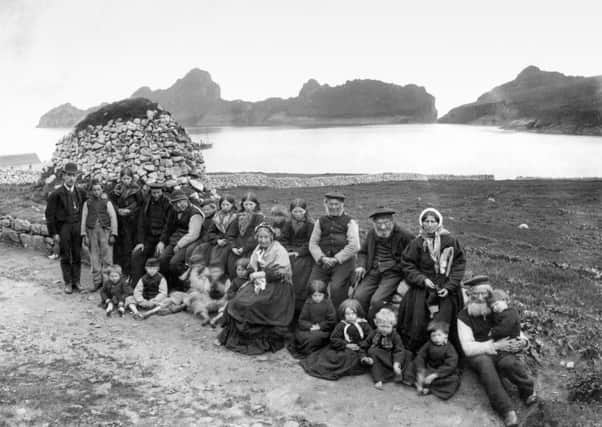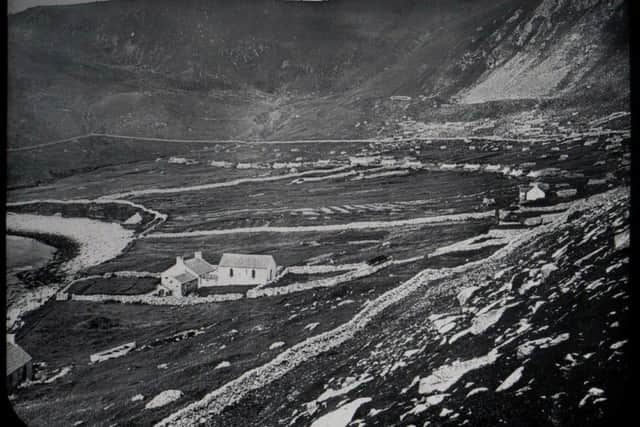On this day 1930: The evacuation of St Kilda


Within two hours, all the houses were locked up and left behind as HMS Harebell collected 13 men, 10 women and 13 children from Hirta, the largest island in the archipelago.
By 8am, everyone was safely aboard the ship with the island soon becoming a “blur on the horizon” for those families who had long called it home.


Advertisement
Hide AdAugust 29, 1930 was the last day that St Kilda, which had been lived on for at least 4,000 years, had a permanent population.
Lieutenant-Commander Pomfret recalled in an account, later published by the St Kilda Club, which works to promote heritage and conservation of the archipelago, the mood of the islanders.
“Contrary to expectations they had been very cheerful throughout, though obviously very tired…”.
However, another account tells of a former residents looking back from the ship towards Hirta and describing their abandoned home as like “an open grave”.
The evacuation came three months after the remaining islanders petitioned the government for help to leave the islands, which sits just over 40 miles west of Benbecula.
According to documents held by the National Records of Scotland (NRS), the start of 1930 the St Kilda community was in a precarious state.
Advertisement
Hide AdThe future looked bleak. The population had fallen away from 90 residents in 1764 with only two families including more than two children by 1930.
Eight or nine widows and widowers were included amongst the adults with emigration to Australia and an influenza breakout in 1912 impacting the population.
Advertisement
Hide AdA NRS article on the evacuation said: “The decision to evacuate the island archipelago was taken because life there was becoming untenable.
“So many islanders had left that the traditional livelihoods of raising sheep for wool, spinning and weaving tweed, fishing, and harvesting of seabird eggs and oil, was much harder to sustain.
“The islanders continued to suffer as weather conditions often prevented adequate food supplies, as well as mail, from being delivered between autumn and spring.
Many islanders felt that they could not continue life on St Kilda after the harsh winter of 1929-30.
The health of the islanders had long been a concern with the remoteness of the island brought into sharp view by the death of two women and a baby.
On May 26, Mary Gillies, 35, of 10 Main Street, who had been rushed to hospital in Glasgow, died of complications after giving birth to her daughter Annie, who also died. She was 35 years old.
Advertisement
Hide AdOn July 21, another Mary Gillies died at 14 Main Street of a form of tuberculosis, aged 22.
On the 10 May 1930, 20 islanders petitioned the government for resettlement on the mainland, according to accounts held by the National Records of Scotland.
Advertisement
Hide AdThe departure of several men from the island, whose tasks included tending sheep, weaving cloth and caring for the widows, meant “it would be impossible to stay on the island another winter.”
The islanders added: “We do not ask to be settled together as a separate community, but in the meantime we would collectively be very grateful of assistance, and transference elsewhere, where there would be a better opportunity of securing our livelihood.”
The petition was also signed by Dugald Munro, the missionary and schoolteacher, and Nurse Barclay, who had been instrumental in organising the petition.
The crossing from Village Bay took 12 hours with 28 residents coming ashore at Lochaline, in the Morvern peninsula, while others headed for Oban and on to Inverness, Portree and Stromeferry.
For St Kildans, there were many first to follow - such as seeing a tree for the first time, or catching sight of a motor car.
Many went on to work in forestry with islanders impressing with their semaphore abilities and climbing skills, according to accounts.
Advertisement
Hide AdOn St Kilda, landowner Sir Reginald MacLeod of MacLeod received requests from those who wanted to move to the islands, but he declined.
Today, St Kilda is home to a small Ministry of Defence base and staff from National Trust for Scotland, which owns the island, and various visiting study and work groups.
Advertisement
Hide AdTraditional food gathering techniques are reflected in the census. It says that the islanders each ate “36 wild fouls eggs and 18 fouls” (seabirds) a day – an overall daily consumption of 3,240 eggs and 1,620 birds.
The last surviving native islander, Rachel Johnson (nee Gillies) died this year aged 93. She was evacuated in 1930.
In 1885 J Acheson, a surgeon, reported that food was abundant on St Kilda but lacked variety.
The islanders lived in houses strung along a ‘main street’, with plots of land and common ground on either side. In 1861 the landlord replaced the traditional thatched ‘blackhouses’ with sixteen single storey cottages with chimneys and slate roofs.
